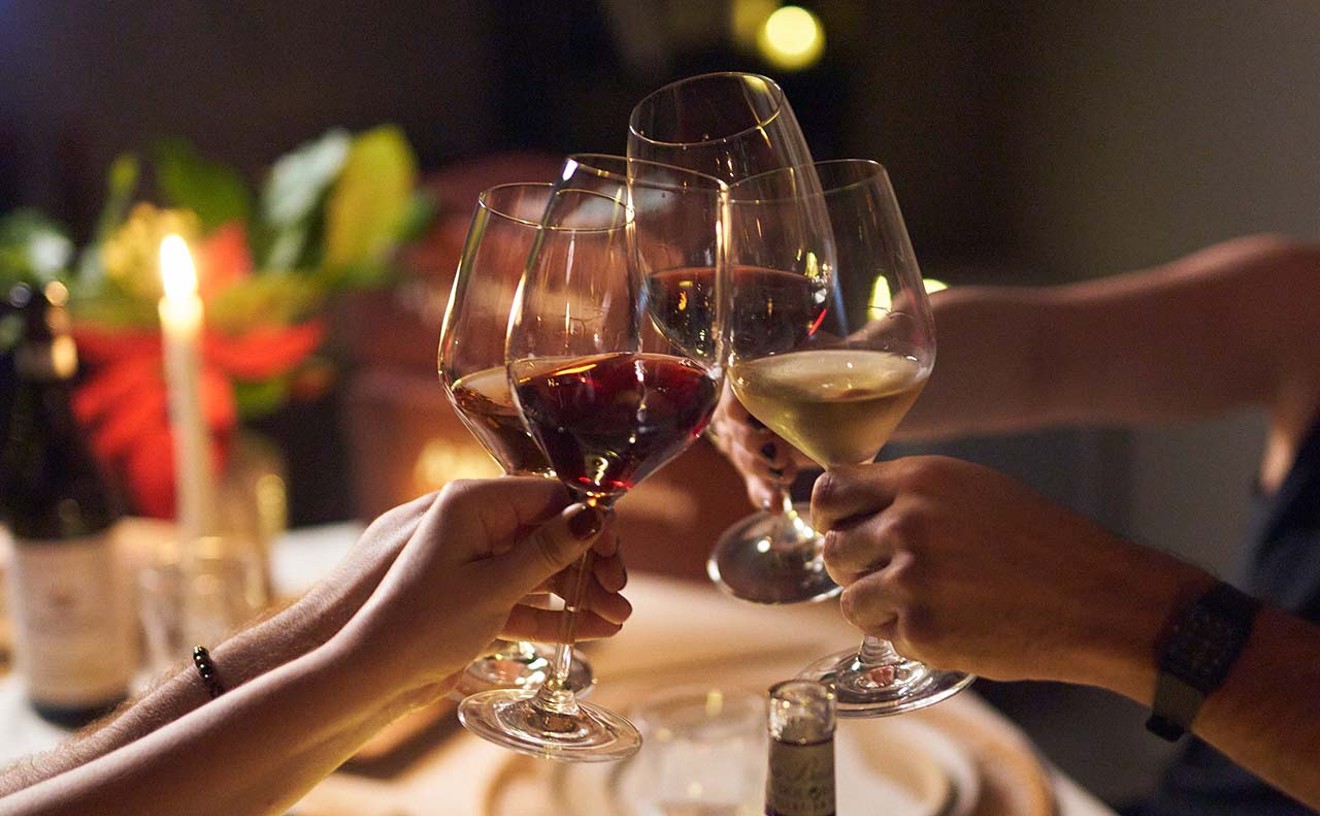Behind all that country-club prose, the man is right. But how far would his requirements get him here? To get an idea, I decided to take Birsh's rather daunting little yardstick to South Beach, that bastion of rotten service where the staff are inexperienced in everything except conniving new schemes to double their guaranteed fifteen percent tip. Where incompetence rules. And where I found Nemo Restaurant, a splashy new eatery owned by Myles Chefetz and chef Michael Schwartz (the team responsible for Southampton's popular restaurant Conscience Point) that actually lives up to this fantasy of service.
"Customers, for their part, must be punctual or, failing that, keep the establishment's front desk apprised of their whereabouts...." At Nemo reservations are like prime real estate. After three weeks of trying for a late-evening weekend table, I gave up and settled for one at eight o'clock. Realizing we were running fifteen minutes behind schedule, we fulfilled our end of Birsh's bargain by calling to adjust our reservation, and Nemo completed the contract. Upon our arrival, we were seated immediately at a wood-topped, iron-legged table on the patio -- one of three outside dining areas perfect for people-watching (plenty are worth the double-take here, starting with the woman who was sucking on a cigar).
In terms of decor, Nemo is almost impossible to describe. Each of the seven separate dining sections showcases different elements, including one rather odd theme of ostrich skins and eggs, which made me wonder if Studiolido president Carl Myers, who designed the place for Chefetz and Schwartz, conceived this particular accent with his head stuck in the sand. Taken as a whole, though, the space is stunning, with a somewhat unifying tone of raw metals and gem stones throughout.
One of Nemo's hottest aspects is a hammered copper "interactive" food bar, where patrons perch to watch chef Schwartz perform while they consume what he prepares. The materials highlighted there are carried through quite literally to the menu, which is pasted on heavy copper sheets. Thanks in part to Schwartz's training at Wolfgang Puck's L.A. prestige palace Chinois, his complex Asian-influenced dishes demand explanation. Which brings up another of Birsh's service points that Nemo neatly earned: "Restaurateurs and chefs must brief their dining room staffs about all the dishes on (and off) the menu.... Those who wait on tables will then be able to make informed recommendations and answer customers' queries (or refer queries they cannot answer to someone who can)." Our waitress was exceptionally menu-knowledgeable and patient, describing the specials three times for us. She did fall down in pronunciation, however, mangling the names of chilies and other spices. Though this might seem a minor point, it's all part of the training. I've seen chefs correct their apprentices when they mispronounce a cooking word. You can't really know what it is if you don't know how to say it.
We couldn't argue with her about the salmon starter, which she'd said was the best on the menu. Cured in garlic and ginger for two days, thin slices of salmon were wrapped around alfalfa sprouts and napped with tobiko caviar (flying fish roe) and a zesty wasabi mayo. This unique take on sushi was refreshing and pretty, the five salmon bundles backed by an exceedingly fresh salad comprising whole radicchio leaves, Belgian endive, and frisee.
The same greens supported a "crispy prawns" appetizer, a pair of large prawns (complete with head) blanketed with shredded phyllo dough and deep-fried. Served with a juicy salsa cruda comprising tomatoes, onions, and papaya, the crustaceans were indeed crusty on the outside and succulent inside. Oyster-miso soup, a bit more complex in flavor, was another shellfish winner, the supple oysters drifting like dumplings in a miso-rich broth that also contained spinach, shiitake mushroom slices, and white cubes of tofu. A gingery, peppery kick surprised the palate after every spoonful, making the soup a natural pairing with a reasonably priced Pacific Rim Riesling ($21.00), a wine practically designed for the strengths in Asian cookery. The only flaw here was the large piece of oyster shell one of us almost swallowed, and which we showed to the waitress immediately (according to Birsh, "Most owners and managers of restaurants want to know right away if something is wrong").
Nothing whatsoever was wrong with the salad. Sliced tomatoes and sweet red onions were topped with Reggiano cheese parings -- one of the few menu items that spoke to the Mediterranean. Kalamata olives and a serious drenching of balsamic vinegar spiked with tarragon added potency to the summery mix, which was served in a Chinese rice bowl. (The blend of various crockeries was strange: Appetizers were arranged on mismatched Asian-patterned tableware; a wonderful sourdough bread was presented in a metal mesh colander; butter came on an oblong of glazed pottery; and huge wood-handled knives were supplied for everything from butter to sirloin. Bread plates don't even exist at Nemo.)
Entrees were served on oversize dinner plates almost as deep as bowls, a configuration that proved ideal for a special that evening, whole grilled pompano finished with a tarragon-shiitake mushroom broth. A bit too salty, the mushroom infusion was nonetheless delicious, complementing the sweet flesh of the fish. A perfumed mound of basmati rice replaced the orzo the waitress had described as an accompaniment -- to the dish's overall advantage, we thought.
Obeying Birsh's dictum that "diners must speak up about food that has arrived...with some element of the dish clearly under- or over-cooked," we sent back a parched piece of wahoo (served with roasted eggplant, bok choy, and miso sauce), so desiccated that my teeth stuck together when I tried to chew it. Our waitress (who surely knew by then that she was up against the table from Hell) was a professional and didn't question my judgment, offering a main course replacement. We selected the mahi-mahi, a pan-seared fillet done to a flaky turn. Scattered with baby sauteed asparagus, the fish was adrift in a lovely "citronette" sauce, a combination of orange, basil, and olive oil.
Spicy pork loin wasn't nearly as delicate, and certainly not for the faint-hearted. Blackened with curry spices (the menu description failed to note these very decisive flavors), two pork filets exhibited a fragrant char. Caramelized onions and a cooling papaya relish similar in construction to the salsa cruda that dressed the shrimp were superb foils for the meat.
A preponderance of fish usually found more on Key West menus (wahoo and cobia) are the primary temptations at Nemo, but one shouldn't overlook the sliced sirloin A top-quality beef marinated and grilled, then presented with a pile of arugula, a fantastic roasted beet salad, and a sprinkle of Roquefort cheese. We ordered our beef rare ("allowances must be made for the preferences of individual customers") and got it that way, delectably blood-red and tender, although minus the Roquefort and the side of black olive mashed potatoes we ordered with the meal. More disturbingly, while the steak was rare, it was also cold throughout, probably due to the volume of food that was passing through the kitchen A the place was packed. When we sent it back for more fire, the sirloin returned medium-pink, but still chilly. Bowing to Birsh ("Chefs and the clientele for whom they cook must be willing to bend in each other's direction"), we shut up and enjoyed. The potatoes, studded with pitted kalamatas, eventually arrived and were consumed with an equal amount of pleasure.
In one of the more unusual moves I've seen on the Beach, Alan Hughes, former head chef at Fellini, moved to Nemo to practice the art of baking. An amazing upside-down chocolate banana cake, with a texture somewhere between hot fudge and a brownie, stood as testimony to his wise decision to turn pastry rather than pasta.
Patrons often ignore poor service or even reward it, returning to a restaurant if they think the food was good enough. I consider it to be an integral part of the meal, perhaps even the make-or-break element. Chefetz and Schwartz, no doubt, agree. Calling Nemo "Miami's first holistic organic restaurant," the duo is striving for something of a philosophical overstatement: individual parts that work together as a whole. In other words, decor, food, service, et cetera should all complement each other. That's an idea that is (or should be) inherent in any restaurant. But no amount of eclectic tableware or exotic wall design can make this thing happen if service is the weak link. The few flaws in our otherwise finely prepared dinner at Nemo would have rendered the evening a disaster had it not been for an experienced waitress -- the all-important spoke in the "holistic organic" wheel.










